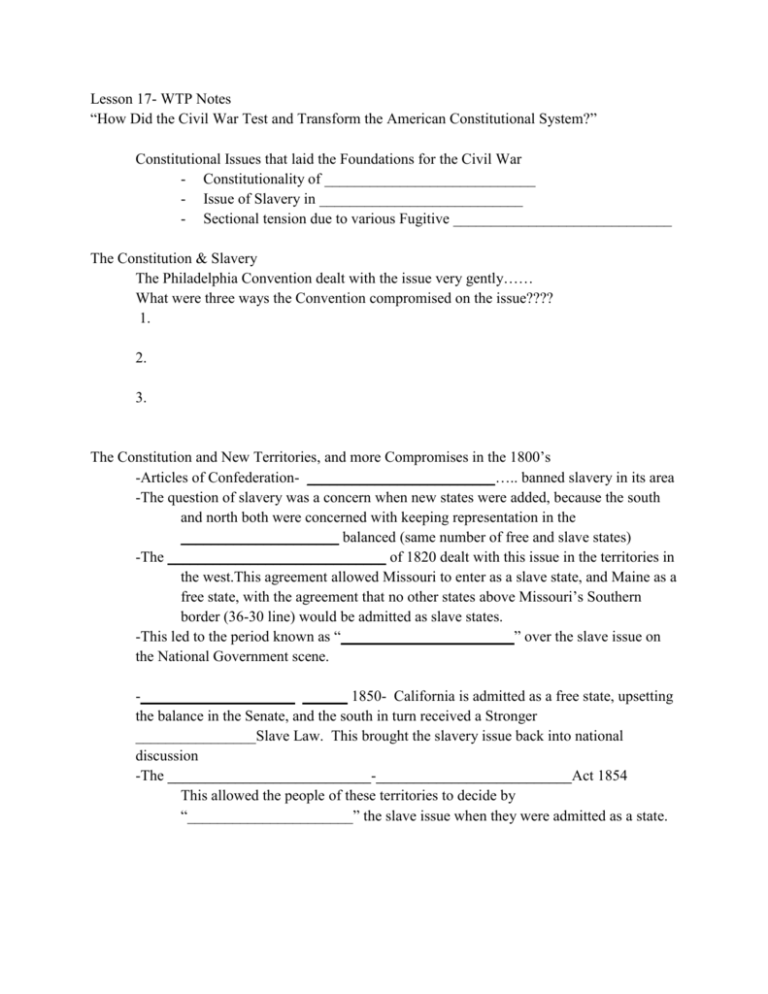L17 Skelly Notes
advertisement

Lesson 17- WTP Notes “How Did the Civil War Test and Transform the American Constitutional System?” Constitutional Issues that laid the Foundations for the Civil War - Constitutionality of ____________________________ - Issue of Slavery in ___________________________ - Sectional tension due to various Fugitive _____________________________ The Constitution & Slavery The Philadelphia Convention dealt with the issue very gently…… What were three ways the Convention compromised on the issue???? 1. 2. 3. The Constitution and New Territories, and more Compromises in the 1800’s -Articles of Confederation- _________________________….. banned slavery in its area -The question of slavery was a concern when new states were added, because the south and north both were concerned with keeping representation in the _____________________ balanced (same number of free and slave states) -The _____________________________ of 1820 dealt with this issue in the territories in the west.This agreement allowed Missouri to enter as a slave state, and Maine as a free state, with the agreement that no other states above Missouri’s Southern border (36-30 line) would be admitted as slave states. -This led to the period known as “_______________________” over the slave issue on the National Government scene. -____________________ ______ 1850- California is admitted as a free state, upsetting the balance in the Senate, and the south in turn received a Stronger ________________Slave Law. This brought the slavery issue back into national discussion -The ___________________________-__________________________Act 1854 This allowed the people of these territories to decide by “______________________” the slave issue when they were admitted as a state. This led to the debate/battle known as “_________________ Kansas” over the issue of slavery. ______________________, an abolitionist, led some free soil battles in Kansas. “____________________” were people that believed no new territory should be admitted as a slave state. The Kansas-Nebraska Act essentially gave southerners hope of gaining new states as slave states, despite the Missouri Compromise of 1820. Dred Scott v. Sandford, 1857 Supreme Court Case This case involved a slave, Dred Scott who was suing for his freedom, due to the fact he had been taken into “non-slave” territory. He began this challenge in 1846, prior to the KS.-Neb. Act. He appealed it many times before it reached the Supreme Court. Three major outcomes of the case include… 1. 2. 3. This decision and its impact divided the nation more on the slave issue. Reading - & Q’s over Dred Scott case Video Just the Facts: Documents of Destiny: Compromise and Conflict Dred Scott v. Sanford 1. African Americans, both free and slaves, could not be citizens of the U.S., therefore they could not bring suit in federal court 2. The Missouri Compromise was unconstitutional. This meant the federal government had no right to make laws banning slavery in any territory. 3. The 5th Amendment Due Process clause protected property rights(protection of life, liberty, and property) which included slaves, so Scott was not free no matter where his owner took him. 3/5ths Compromise No ban on slave trade until 1808 Fugitive Slave clause of Art. IV, Section 2






